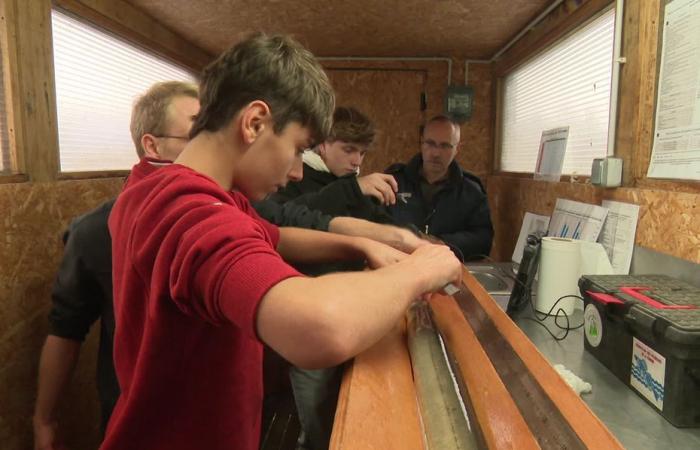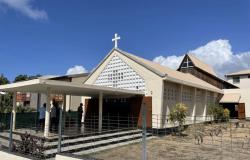They hold in their hands a fish threatened with extinction: the students of the MFR of Eclusier-Vaux assist the Somme fishing federation every year in monitoring eel populations. An initiative that contributes to the international effort to preserve this species.
The essentials of the day: our exclusive selection
Every day, our editorial team reserves the best regional news for you. A selection just for you, to stay in touch with your regions.
France Télévisions uses your email address to send you the newsletter “Today’s essentials: our exclusive selection”. You can unsubscribe at any time via the link at the bottom of this newsletter. Our privacy policy
In a meander of the Somme, the morning mist still clings to the ponds of Éclusier-Vaux. The water bubbles around a wooden structure, a long rectangle at the bottom of which four young men are busy removing the stems of the water lilies, which cling to the slats during the fall.
The structure is an eel trap: a centuries-old trap where silver eels are caught as they rush down the Somme to reach the sea and begin their long journey towards their breeding grounds, off the coast of the Caribbean. Twice a week, from October to March, students from the Éclusier-Vaux MFR come to lend a hand to technicians from the Somme fishing federation to monitor this eel population, threatened with extinction.
A beautiful specimen was caught in the trap on the night of November 7 to 8. One of the MFR students goes down into the tank to catch it using a landing net. As soon as the fish is caught in the net, its comrades move to transfer it into a large bucket of water.
“There, we let her rest because we have just taken her out of the trap, we let her relax a little. When the students are ready to carry out the manipulations, we will put the fish to sleep” announces Théau Brasseur, head of scientific studies for the Somme fishing federation. He then explains to the students how to dose the anesthetic into a second bucket, where the eel is immersed a few minutes later.
In addition to monitoring the populations, the students of Eclusier-Vaux participate in the maintenance of this eel, preserved by the department.
•
© Laurent Pénichou / FTV
For handling, it is Vincent Danneau, student of the professional aquaculture production baccalaureate, who grabs the fish. The eel is installed on a previously wetted support, where it can be measured and observed. “We took information on the size of the eyes, the fins, its weight, to know how it is, healthy or not, explains Vincent Danneau. I like that, it's a pretty cool activity to do.”
You have to go quickly, the anesthesia only lasts a few minutes and the fish must not stay in the air for too long, otherwise it will suffocate. “She wakes up” warns Théau Brasseur. Just long enough for a weighing, then the eel is reintroduced into its recovery tank.
This monitoring campaign has been taking place for around ten years, many MFR students have been trained in fish handling. “Above all, we transmit to them a scientific approach, a protocol, this requires rigor and precision.observe Antoine Rollero, responsible for the Bac Pro aquaculture production at the MFR of Éclusier-Vaux. This allows them to practice what we call biometrics with anesthetizing the fish, waking them up and taking very, very precise measurements.”
Beyond being a learning moment for students, this follow-up campaign has a major ecological issue. Because the European eel, once very common, is now on the red list of critically endangered species.
“Scientific authors clearly say that we are facing a massive collapse of the species. On average, each season, there are between 200 and 650 eels, it may seem enormous, but it is incomparable with the numbers that we could have had in the past. notes Théau Brasseur.
“We have been doing this monitoring for 12 years, the results are a little worrying, the figures are decreasing” agrees Antoine Rollero. All the data collected by the students and the fishing federation are recorded in a box, which transmits the data to the scientists of the French Biodiversity Office (OFB), responsible for monitoring the management plan of eel, an effort to conserve the species in different European countries.
Before being handled, the eel is anesthetized. It will then be released to continue its migration to the other side of the Atlantic.
•
© Laurent Pénichou / FTV
“The objective of the management plan and the European regulation is to ensure the survival of the eel in the long term.explains Laurent Beaulaton, project manager on migratory fish for the OFB. Here, we are in a critical situation, the idea is that the backup plan lasts as long as necessary. Once stock is restored, protective measures will remain.”
The plight of the eel is due to several human factors. Between 1964 and 1985, the species was considered harmful, because it was accused of harming the growth of young salmon. A theory whose scientific foundations have since been called into question, salmon having mainly disappeared due to pollution. The fact remains that at the time the eel was the subject of destruction fishing and returning a caught specimen to the water was prohibited. This attack on adult specimens took place in parallel with intense fishing for glass eels, these very young transparent eels. It is scientific work observing the disappearance of the fish which has changed the attitude towards this species.
The regulation to protect the eel at European level was adopted in 2007 and the national plan, put in place in December 2008. It includes measures to restrict fishing, preserve water quality and restore continuity. ecological, in addition to population monitoring implemented in Éclusier-Vaux and a few other places in France.
“The eel is a fish that lives relatively long. It depends on the growing areas, for the Somme eel, it is rather one to two decadesspecifies Laurent Beaulaton. So the management measures that we are going to take, which will improve the survival of young eels, will take several years, even decades, to be seen in the monitoring of silver eels.“
Because it is only at the end of their adult life that eels take on this characteristic gray color and migrate towards their place of birth and reproduction, the Sargasso Sea, on the other side of the Atlantic Ocean. There, the entire European population reproduces, an eel from the Somme can cross paths with an eel from Norway or North Africa, so there is only one “stock” of European eel. Conservation efforts must therefore be implemented in several countries to be effective.
We are no longer in this very downward slope that we have experienced for 30 years, we are at a fairly stable level, even if it remains very low.
Laurent BeaulatonMigratory fish project manager – OFB
The eel cannot be bred in captivity, which makes it even more fragile. “We know how to obtain fertilized eggs, but we cannot raise the larvae. This is the particularity of the cycle of the European eel which crosses the ocean from the Sargassum Sea. This crossing lasts two to three years, we don't even know exactly, and during this time, the larvae from the fertilized eggs need certain living conditions, which we cannot reproduce artificially. The eels that we find in our rivers or sometimes on our plates are necessarily wild eels.” adds Laurent Beaulaton.
Today, only a tiny percentage remains of the population of the 1960s and 1970s, considered by scientists to be the baseline. The main indicator of the survival of the species is the observation of glass eels, carried out at European level. And this gives a glimmer of hope.
“Since the 1980s, there has been a continuous decline in these arrivals of glass eels. There, it's been a good decade since we stopped declining, that is to say that the number of glass eels does not decrease from year to year. We are on a sort of plateau, or even a slight increase, depending on how you look at the figures. In any case, we are no longer in this very downward slope that we have known for 30 years, we are at a fairly stable level, even if it remains very low” notes Laurent Beaulaton.
It will still take years to know whether eel protection measures will succeed in saving this species with its mysterious habits. But day after day, the efforts of scientists, technicians and students from Éclusier-Vaux contribute to the advancement of knowledge about this endangered fish.






